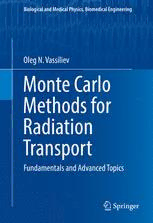Table Of ContentBiological and Medical Physics, Biomedical Engineering
Oleg N. Vassiliev
Monte Carlo
Methods for
Radiation
Transport
Fundamentals and Advanced Topics
BIOLOGICAL AND MEDICAL PHYSICS,
BIOMEDICAL ENGINEERING
BIOLOGICAL AND MEDICAL PHYSICS,
BIOMEDICAL ENGINEERING
The fields of biological and medical physics and biomedical engineering are broad, multidisciplinary and
dynamic.Theylieatthe crossroadsof frontier researchinphysics,biology, chemistry,andmedicine.The
BiologicalandMedicalPhysics,BiomedicalEngineeringSeriesisintendedtobecomprehensive,coveringa
broadrangeoftopicsimportanttothestudyofthephysical,chemicalandbiologicalsciences.Itsgoalisto
providescientistsandengineerswithtextbooks,monographs,andreferenceworkstoaddressthegrowingneed
forinformation.
Booksintheseriesemphasizeestablishedandemergentareasofscienceincludingmolecular,membrane,
and mathematical biophysics; photosynthetic energy harvesting and conversion; information processing;
physicalprinciplesofgenetics;sensorycommunications;automatanetworks,neuralnetworks,andcellular
automata. Equally important will be coverage of applied aspects of biological and medical physics and
biomedicalengineeringsuchasmolecularelectroniccomponentsanddevices,biosensors,medicine,imaging,
physical principles of renewable energy production, advanced prostheses, and environmental control and
engineering.
Editor-in-Chief:
EliasGreenbaum,OakRidgeNationalLaboratory,OakRidge,Tennessee,USA
EditorialBoard:
MasuoAizawa,DepartmentofBioengineering, HansFrauenfelder,
TokyoInstituteofTechnology,Yokohama,Japan LosAlamosNationalLaboratory,
OlafS.Andersen,DepartmentofPhysiology, LosAlamos,NewMexico,USA
Biophysics&MolecularMedicine, IvarGiaever,RensselaerPolytechnicInstitute,
CornellUniversity,NewYork,USA Troy,NewYork,USA
RobertH.Austin,DepartmentofPhysics, SolM.Gruner,CornellUniversity,
PrincetonUniversity,Princeton,NewJersey,USA Ithaca,NewYork,USA
JamesBarber,DepartmentofBiochemistry, JudithHerzfeld,DepartmentofChemistry,
ImperialCollegeofScience,Technology BrandeisUniversity,Waltham,Massachusetts,USA
andMedicine,London,England
MarkS.Humayun,DohenyEyeInstitute,
HowardC.Berg,DepartmentofMolecular
LosAngeles,California,USA
andCellularBiology,HarvardUniversity,
Cambridge,Massachusetts,USA PierreJoliot,InstitutedeBiologie
Physico-Chimique,FondationEdmond
VictorBloomfield,DepartmentofBiochemistry,
deRothschild,Paris,France
UniversityofMinnesota,St.Paul,Minnesota,USA
LajosKeszthelyi,InstituteofBiophysics,Hungarian
RobertCallender,DepartmentofBiochemistry,
AcademyofSciences,Szeged,Hungary
AlbertEinsteinCollegeofMedicine,
Bronx,NewYork,USA PeterW.King,BiosciencesCenter&Photobiology
StevenChu,LawrenceBerkeleyNational Group,NationalRenewableEnergyLaboratory,Golden,
Laboratory,Berkeley,California,USA Colorado,USA
LouisJ.DeFelice,DepartmentofPharmacology, RobertS.Knox,DepartmentofPhysics
VanderbiltUniversity,Nashville,Tennessee,USA andAstronomy,UniversityofRochester,Rochester,
NewYork,USA
JohannDeisenhofer,HowardHughesMedical
Institute,TheUniversityofTexas,Dallas, GianlucaLazzi,DepartmentofElectricalandComputer
Texas,USA Engineering,TheUniversityofUtah,SaltLakeCity,
Utah,USA
GeorgeFeher,DepartmentofPhysics,
UniversityofCalifornia,SanDiego,LaJolla, AaronLewis,DepartmentofAppliedPhysics,
California,USA HebrewUniversity,Jerusalem,Israel
(Continuedonnextpage)
StuartM.Lindsay,DepartmentofPhysics LindaS.Powers,UniversityofArizona,
andAstronomy,ArizonaStateUniversity, Tucson,Arizona,USA
Tempe,Arizona,USA EarlW.Prohofsky,DepartmentofPhysics,
DavidMauzerall,RockefellerUniversity, PurdueUniversity,WestLafayette,Indiana,USA
NewYork,NewYork,USA TatianaK.Rostovtseva,NICHD,NationalInstitutes
EugenieV.Mielczarek,DepartmentofPhysics Health,Bethesda,Maryland,USA
andAstronomy,GeorgeMasonUniversity,Fairfax, AndrewRubin,DepartmentofBiophysics,Moscow
Virginia,USA StateUniversity,Moscow,Russia
MarkolfNiemz,MedicalFacultyMannheim, MichaelSeibert,NationalRenewableEnergy
UniversityofHeidelberg,Mannheim,Germany Laboratory,Golden,Colorado,USA
V.AdrianParsegian,PhysicalScienceLaboratory, DavidThomas,DepartmentofBiochemistry,
NationalInstitutesofHealth,Bethesda, UniversityofMinnesotaMedicalSchool,
Maryland,USA Minneapolis,Minnesota,USA
Moreinformationaboutthisseriesathttp://www.springer.com/series/3740
Oleg N. Vassiliev
Monte Carlo Methods
for Radiation Transport
Fundamentals and Advanced Topics
123
OlegN.Vassiliev
DepartmentofRadiationPhysics
TheUniversityofTexas
MDAndersonCancerCenter
Houston,TX,USA
ISSN1618-7210 ISSN2197-5647 (electronic)
BiologicalandMedicalPhysics,BiomedicalEngineering
ISBN978-3-319-44140-5 ISBN978-3-319-44141-2 (eBook)
DOI10.1007/978-3-319-44141-2
LibraryofCongressControlNumber:2016954643
©SpringerInternationalPublishingSwitzerland2017
Thisworkissubjecttocopyright.AllrightsarereservedbythePublisher,whetherthewholeorpartof
thematerialisconcerned,specificallytherightsoftranslation,reprinting,reuseofillustrations,recitation,
broadcasting,reproductiononmicrofilmsorinanyotherphysicalway,andtransmissionorinformation
storageandretrieval,electronicadaptation,computersoftware,orbysimilarordissimilarmethodology
nowknownorhereafterdeveloped.
Theuseofgeneraldescriptivenames,registerednames,trademarks,servicemarks,etc.inthispublication
doesnotimply,evenintheabsenceofaspecificstatement,thatsuchnamesareexemptfromtherelevant
protectivelawsandregulationsandthereforefreeforgeneraluse.
Thepublisher,theauthorsandtheeditorsaresafetoassumethattheadviceandinformationinthisbook
arebelievedtobetrueandaccurateatthedateofpublication.Neitherthepublishernortheauthorsor
theeditorsgiveawarranty,expressorimplied,withrespecttothematerialcontainedhereinorforany
errorsoromissionsthatmayhavebeenmade.
Printedonacid-freepaper
ThisSpringerimprintispublishedbySpringerNature
TheregisteredcompanyisSpringerInternationalPublishingAG
Theregisteredcompanyaddressis:Gewerbestrasse11,6330Cham,Switzerland
Inmemoryofmyparents
Thenareyousocertainthatyourrouletteplayingwillgetus
outofourdifficulties?
F.Dostoevsky,“TheGambler”
Preface
This book is intended as an introductory graduate-level text on the application of
the Monte Carlo method to radiation transport problems. The target audience is
radiation medical physicists: students, faculty members, and researchers special-
izing in radiotherapy physics, medical imaging, or nuclear medicine. The book
should be of interest to clinicians as well, because Monte Carlo-based software,
no longer confined to the research environment, is gradually finding its way into
routineclinicalpractice.
The types of problems that are important in the field of medical physics
determined the material that was selected for the book. Rather than focusing on
the practical application of Monte Carlo techniques, however, the book focuses
on the fundamentals of the method: its mathematical foundations, the numerical
techniques on which it relies, its optimization strategies, and the statistical aspect
of its calculations. With this approach, most of the information is quite general,
andpartsshouldbeusefultoabroadaudience.Moreadvancedtopicsareincluded
as well, such as the adjoint formulation of the transport problem, the transport
of charged particles in an external magnetic field, microdosimetry, elements of
stochastictransporttheory,andgrid-basedsolvers.Inclusionofthesetopicsmakes
the text more complete and extends the book into areas of recent significant
developments.
An important objective of this book is to introduce the basic concepts, termi-
nology, and formalism of radiation transport theory. This material, of course, is
necessary to understand how transport problems are solved with the Monte Carlo
method. It is also of significant interest in its own right because it is the basis for
methods other than Monte Carlo, analytical and numerical, that have been used
extensively in radiation medical physics. Several such methods are covered in the
book.
OurdidacticapproachreflectstheviewexpressedbyN.MetropolisandS.Ulam
in their seminal paper “The Monte Carlo method” (1949) that Monte Carlo is
a “statistical approach to the study of differential equations, or more generally,
of integro-differential equations.” The equation that we study in this book is the
ix
x Preface
Boltzmanntransportequation.Forthisreason,wededicateanentirechaptertothe
equationanditsvariousforms.Onlyaftertheequationisexplaineddoweintroduce
algorithmsforsolvingit.
Thechaptersandappendixofthebookcanbesummarizedasfollows:
• Chapters 1 and 2 present a general introduction to the Monte Carlo method
with an emphasis on sampling techniques, an essential element of any Monte
Carloalgorithm.Samplingtechniquesareusedtogeneraterandomnumbersand
vectorsthathavedistributionsrequiredbythealgorithm.
• Chapter 3 begins with definitions of the fundamental quantities of radiation
transport theory, such as cross sections, free path, and fluence. Next is a rather
elementaryintroductiontotheBoltzmannequationfollowedbyexamplesofits
various forms. We conclude the chapter with more advanced topics: a general
algorithmforsolvingtheBoltzmannequationwiththeMonteCarlomethodand
the related topic of biasing techniques, which together form the mathematical
basisforalgorithmoptimization.
• Chapter 4 discusses three main components of a Monte Carlo algorithm for
radiation transport problems: generation of a particle trajectory, tallying, and
variance reduction. Tallying is the process of deriving a numerical estimate of
a quantity of interest from information contained in particle trajectories. Here,
andthroughoutthebook,thewordestimateisusedinsteadofcalculatebecause
MonteCarloisastatisticalmethod.Thisbynomeansimpliespooraccuracyof
theresult.Variancereductionisabroadtermreferringtoavarietyofoptimization
methodsthatreducestatisticaluncertaintieswithoutintroducingsystematicerror
orbias.
• Chapter 5 is dedicated to the transport of charged particles such as electrons,
protons,andheavyions.MostMonteCarloalgorithmsforchargedparticlesrely
on multiple scattering models. We cover all the classic models for energy loss
fluctuations (energy straggling), angular distribution, and transverse and longi-
tudinalspatialdisplacements.Thischapteralsoincludessectionsontransportin
magneticfieldsandthechargeexchangeprocess,whichisparticularlyimportant
neartheendofaheavyiontrack.
• Inthelasttwochapters,Chaps.6and7,wepresenttwoadvancedtopics:micro-
dosimetry with elements of stochastic transport theory and grid-based solvers
of the Boltzmann equation. The calculation of microdosimetric characteristics
is a problem fundamentally different from more conventional problems, such
as the dose calculation, because the Boltzmann equation is not applicable in
this case. For this reason, in this chapter, we introduce another equation, the
stochastic transport equation, and discuss algorithms for solving it. Grid-based
Boltzmann equation solvers are deterministic algorithms that present a viable
alternative to Monte Carlo. The best-known algorithm of this type is Acuros
(Vassiliev et al. 2010), which was translated into the clinic almost instantly,
for treatment planning for radiotherapy of cancer. The grid-based Boltzmann
equation solver, however, remains a relatively new technology and has the
potentialforimprovementandforuseinnewapplications.InChap.7,weexplain
step-by-stephowanalgorithmofthistypeworks.

